Five Simple Spreads for Waterfowl
Hunt more efficiently and effectively this season with these downsized decoy strategies
Hunt more efficiently and effectively this season with these downsized decoy strategies

By John Pollmann
Illustrations by Kevin Hand
There is no question that a massive decoy spread will command the attention of passing flocks of waterfowl, but the time, effort, and expense required to maintain a huge rig can be a challenge, especially for newcomers to the sport. The fact is, if you set up in a spot where the birds want to be, you can often be just as successful with a small spread as with a large one. And in some situations a smaller, simpler rig will actually decoy more birds.
The following spreads offered by veteran waterfowlers consist of no more than three dozen decoys. Sure, there are going to be hunts when you'll probably want to go with a bigger spread, but there will also be times when it pays to go small. Here are five downsized decoy spreads that just might help you put more birds in the bag this season with a lot less work.
VETERAN WATERFOWLER
Mike Bard, New York
CREDENTIALS
Hunt club owner and guide
SPECIES HUNTED
Mallards, black ducks, teal, woodies
HABITAT
Small marshes, creeks, backwaters
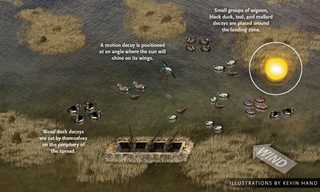
During the early season, Mike Bard typically hunts on small marshes, creeks, and backwaters where local wood ducks, green-winged teal, mallards, and black ducks feed and rest. To get to these secluded spots, he either walks in or uses a small canoe, so he leaves the big bags of decoys at home. "A small decoy spread works well during the first few weeks of the season because the ducks are not concentrated in big numbers," says Bard, who is an owner and guide at a hunt club near New York's Montezuma National Wildlife Refuge.
Bard's early-season dabbler spread consists of two to three dozen decoys, which he divides by species into small groups and places along the edges of wetland vegetation surrounding the landing hole. It's not uncommon to see bunches of mallards and teal feeding together, he says, so he will often group those species together. "Wood ducks, on the other hand, always seem to be doing their own thing," Bard explains, "and I keep the black duck decoys separated from the other species as well. I also include a small group of wigeon, pintails, or other early-migrating species if I see any of these birds in the area while I'm scouting."
To increase the visibility of his spread, Bard uses a spinning-wing decoy equipped with a remote control, which allows him to turn the decoy on and off while ducks are working. "I set the motion decoy 10 to 15 yards away from us, so it won't draw attention to our blind," he says. "I always position the decoy at an angle where the sun will illuminate the spinning wings."
VETERAN WATERFOWLER
Tony Vandemore, Missouri
CREDENTIALS
Hunt club owner and guide
SPECIES HUNTED
Mallards, woodies, other dabblers
HABITAT
Flooded bottomlands

Tony Vandemore has learned from experience that when heavy autumn rains flood the river bottoms of north-central Missouri, mallards and wood ducks will appear immediately on the heels of the rising water. Every waterfowl hunter should experience hunting in flooded timber at least once, he says, and you don't need a big spread of decoys to do it. "In the small timber holes that I hunt, you don't have to use a lot of decoysmaybe three dozen at most," says Vandemore, who is co-owner of Habitat Flats, an intensively managed commercial hunting property near Sumner. "Add a jerk string and some calling and you're set."
Vandemore's timber setup is simple. He places the majority of his spread on the upwind side of the hole and deploys only six decoys on the far downwind side. "Once the ducks clear the treetops and drop into the hole, they tend to float back and forth between the two groups of decoys," he explains. "This seems to confuse the birds a bit and keeps them looking around for a place to land, instead of fading back downwind and landing in the trees out of range."
Vandemore prefers to use a downsized decoy spread when hunting in many other habitats as well. "When you're hunting in a place where you have to bump loafing birds off a resting area, it's crucial to set up quickly because it usually doesn't take long for those ducks to start trickling back in," he says. "A small spread consisting of a couple of dozen Texas-rigged decoys can be set out in a hurry, so you're ready for the first flock. When you have scouted and know where you need to be, a smaller decoy spread is the perfect choice."
VETERAN WATERFOWLER
Bill Willroth, South Dakota
CREDENTIALS
Owner of Dakota Decoy Company
SPECIES HUNTED
Mallards, pintails, other puddle ducks
HABITAT
Small potholes and sloughs
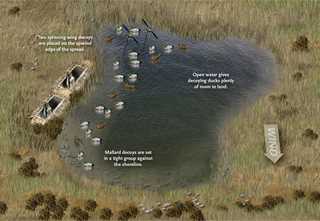
Bill Willroth, owner of Dakota Decoy Company, discovered the hard way that bigger is not always better when it comes to decoying puddle ducks on prairie potholes. While scouting near Devils Lake, North Dakota, Willroth found a small slough, roughly 30 yards wide, that was being used by several dozen mallards, pintails, and assorted other puddle ducks. "The next morning, we set up in the dark, and put out four dozen fully flocked floating decoys and several wing-spinners," Willroth says. "In our eyes, the spread looked spectacular."
When the first small bunch of mallards arrived at shooting light, Willroth expected them to drop their orange feet and pitch right into the rig, but he was shocked by what happened next. "When the ducks sailed over the rushes, they instantly flared. Then three or four more bunches did the exact same thing, so we knew something was wrong," he says.
Willroth and his hunting partners began adjusting the spread by removing most of the motion decoys, but the next flock of mallards responded in similar fashion. "So we pulled two dozen of the duck decoys and tucked the remaining two dozen tight against the reeds. As soon as we took cover, birds started coming back and decoying without hesitation," he recalls. "The next half hour was unbelievable."
While it's impossible to know exactly what the ducks didn't like about Willroth's initial spread, he believes that the large number of decoys simply didn't look natural in that particular spot. "It was a great lesson, and I've used this simple spread in similar places ever since with great success," he says. "The key is to leave most of the water open and put the decoys tight against the bank where your blind is located. The ducks will land short of the decoys, but will still finish close enough for good shots."
PRO TIP: On small ponds and potholes, ducks can land short of the decoys and still finish close enough for good shots.
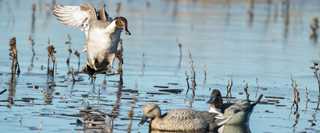
Photo Scott Fink
VETERAN WATERFOWLER
Scott Roduner, California
CREDENTIALS
Hard Core Decoys pro staff
SPECIES HUNTED
Mallards
HABITAT
Backwater ponds

Rice farming in California's Sacramento Valley keeps Scott Roduner extremely busy during most of the year, but he carves out as much time as possible after the harvest to hunt ducks. While this region supports some of the largest concentrations of wintering waterfowl in the world, the birds can be challenging to hunt. "The hunting pressure in this area is tremendously high," says Roduner, who serves as the Pacific Flyway pro staff manager for Hard Core Decoys. "Day after day, these ducks are seeing the same big spreads of eight to 10 dozen decoys, many of which are left out all season long. It doesn't take long for the birds to get used to that game."
Roduner targets mallards in backwater ponds off rivers, where the birds come to loaf after feeding in surrounding rice fields. Believe it or not, his spread consists of only four mallard decoys, which he rigs on a jerk string placed on the far upwind side of the pond.
"I know it's unusual to use so few decoys, but it works," Roduner says. "The key is that every decoy on the water is moving. That's what the ducks are attracted to, and they don't see that in large spreads, where many of the decoys are motionless."
Roduner says that his minimalist spread is especially attractive to pairs and small flocks of mallards flying along the river channel. A few single quacks and feeding chatter are all the calling that is required to help finish birds in small ponds. "There are days when we don't call at all," Roduner says. "It really comes down to how the birds are responding and how much pressure they are receiving on the public areas and private clubs around us. It's always a good idea to keep up with what other hunters in the area are doing. I like to decoy birds in close, so if there is an opportunity for me to do something different that will appeal to the birds, I do it."
VETERAN WATERFOWLER
Ben Cade, Minnesota
CREDENTIALS
Avery Outdoors pro staff
SPECIES HUNTED
Giant Canada geese
HABITAT
Small rivers and backwater sloughs
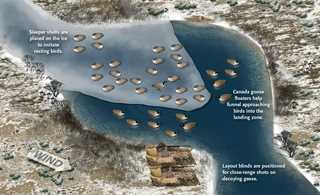
When bitter-cold weather arrives in Minnesota, Ben Cade turns his attention to local rivers where giant Canada geese often congregate on the last remaining sections of open water. His favorite places to hunt are shallow backwater sloughs adjacent to larger river channels, which are often partially frozen during the late season. While the conditions may be extreme, his decoy spread consists of only a dozen Canada goose floaters and two dozen sleeper shells, with one or two full-body decoys added to the mix.
"You could use more decoys, but I haven't found the need," says Cade, who is a member of the Avery Outdoors pro staff. "Even in situations where I'm running traffic on geese traveling up and down the river, this smaller spread works."
According to Cade, the secret to the success of his small decoy spread is the use of sleeper shells, which accurately imitate the behavior of geese in wintry weather conditions. "As soon as the snow and cold arrive, I'm digging out the sleeper shells," Cade says. "If you watch geese on resting areas, as soon as their feet touch the ground, they sit down, and they often stay put for hours, conserving energy until they leave to feed.
"Plus, using shell decoys is a real space saver," he adds. "I've gotten away from the big trailer full of decoys and gear. With shells, I can fit everything I need for a day's hunt in the back of my truck."
Cade places his floating goose decoys in a manner that helps funnel approaching birds into a landing zone that extends onto an ice shelf in shallow water (never walk on ice over deep water or current), where the sleeper shells and full-bodied decoys are located. Shooters are positioned off to one side of the landing zone for crossing shots as incoming flocks make their final approach.
PRO TIP: If you watch geese on resting areas, as soon as their feet touch the ground, they sit down, and they often stay put for hours, conserving energy until they leave to feed.
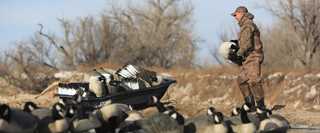
Photo DougSteinke.com
Ducks Unlimited uses cookies to enhance your browsing experience, optimize site functionality, analyze traffic, and deliver personalized advertising through third parties. By continuing to use this site, you agree to our use of cookies. View Privacy Policy